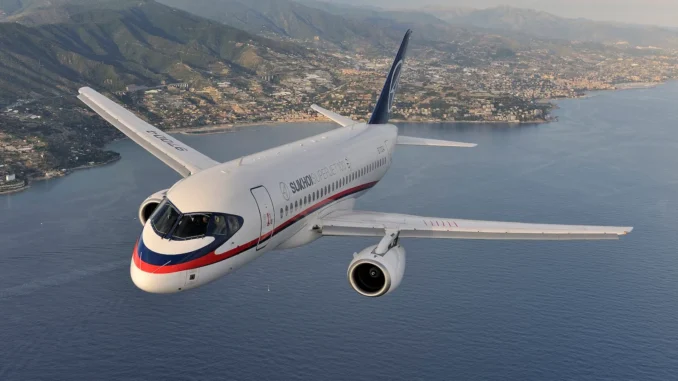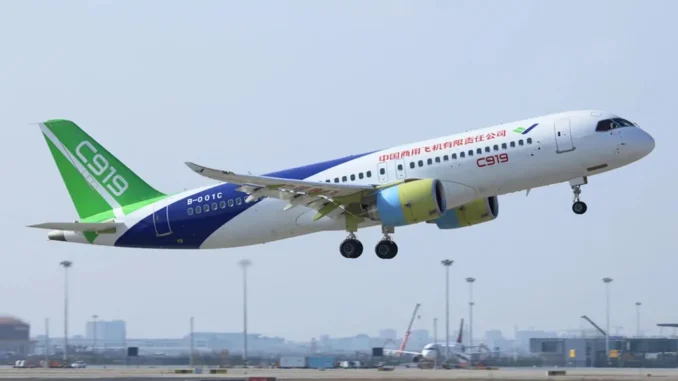J-100 jettisons previous reliance on Western-made parts and systems in import substitution program that tracks China’s C919
 The Sukhoi Superjet 100 (SSJ-100). Photo: Wikipedia
The Sukhoi Superjet 100 (SSJ-100). Photo: Wikipedia
A Russian passenger jet built almost entirely with domestically manufactured components completed its first test flight on August 29, a launch that gave Yakovlev Design Bureau and United Aircraft Corporation’s (UAC) respective shares on the Moscow Exchange a buoyant lift.Designed by Yakovlev and manufactured by UAC at its Komsomolsk-na-Amure factory, the new Sukhoi Superjet 100 (SSJ-100) is a narrow-body regional aircraft with a range of 4,578 kilometers (2,472 nautical miles) that can carry 87 to 108 passengers depending on seat configurations.
It aims to compete with Brazil’s narrow-body, short to medium-range Embraer E190 on global markets.
During the test flight, which lasted 54 minutes, the SSJ-100 climbed to a maximum elevation of 3,000 meters and reached a speed of 343 kilometers per hour, according to local reports. Russia’s Ministry of Industry and Trade said that the stable operation of all systems and the controllability and stability of the aircraft in flight were all confirmed.
The original SSJ-100, constructed largely with foreign parts and components, first flew in 2008. About 40 imported systems and components have been replaced with Russia-made alternatives in the new version.
The indigenously-made parts include the fuselage, avionics, flight control system and auxiliary power unit as well as power supply, air conditioning and fire protection equipment in the plane’s cabin.
SaM-146 engines built in a joint venture between Safran Aircraft Engines of France and the Saturn subsidiary of Russia’s United Engine Corporation (UEC) were used to speed up the test program, but they will be replaced with fully domestic-made PD-8 engines produced by UEC-Saturn “in the near future,” according to Russian media reports. Manufactured in both France and Russia, SaM-146 engines powered the SSJ-100 from the start.
However, SSJ-100 aircraft equipped with PD-8 engines will need to be tested separately. The original schedule called for certification by the end of 2023, but Andrey Velichko, head of the internet portal Russian Aviation, thinks by August next year is a more realistic timeframe. Deliveries to Aeroflot and other domestic airlines are planned to follow.
A comparison with China’s COMAC C919 passenger jet is instructive. The C919, which made its first commercial flight last May, is assembled in China but key components are procured from foreign suppliers, including big American aerospace companies, and their joint ventures in China.
These include LEAP turbofan jet engines from CFM International, a joint venture between GE Aviation and Safran; avionics and cabin systems from Collins Aerospace; flight controls, wheels and brakes from Honeywell; and hydraulics, actuators and fuel systems from Parker Aerospace.
Chinese subcontractors supply the C919’s fuselage, wings, forged parts and other basic components and materials. An alternative engine, the CJ-1000A developed by Aero Engine Corporation of China, was reportedly undergoing flight tests last March. Certification for the C919 may be possible by 2025, according to speculative news reports.
Russia’s aircraft import substitution program dates back to the imposition of restrictions on the export of products with military applications to Russia by the Bureau of Industry and Security of the US Department of Commerce before the Ukraine war.
In September 2018, restrictions were imposed on sales of carbon fiber materials to Russia’s AeroComposite corporation, a subsidiary of UAC. Two years later, in December 2021, Russian aircraft manufacturer Irkut completed its first passenger aircraft with wings made from substitute materials produced by Aero Composite.
“I would like to note that Irkut specialists were able to solve the problem of import substitution in the shortest possible time,” Sergei Chemezov, CEO of state-run defense conglomerate Rostec, was quoted saying by Composites World magazine. “This is proof of the maturity of our aviation technologies and another victory over the sanctions.”
UAC was established in 2006 through the merger of Russian aircraft manufacturers Ilyushin, Irkut, Mikoyan, Sukhoi, Tupolev and Yakolev – all names from the Soviet era. It is 92.3% owned by Rostec, or Russia’s State Corporation for the Promotion of the Development, Manufacture and Export of High-Tech Products. UEC-Saturn is also controlled by Rostec.
Primarily a defense contractor, Rostec was sanctioned by the US and EU after Russia annexed Crimea in 2014. Those sanctions have not apparently been successful either. On September 1, 2023, Rostec announced that it had developed an internet of things software solution “designed to control the status of armament, special-purpose machines and military objects – from ships and vehicles to hospitals and garrisons – and to generate their digital twins.”<
In March 2022, soon after the invasion of Ukraine, France’s Airbus and America’s Boeing shut down their operations in Russia. The sale of aircraft and spare parts, technical support and maintenance were all officially terminated in line with EU and US sanctions. About 70% of the passenger aircraft operating in Russia were affected.
In August 2023, Reuters reported that at least US$1.2 billion worth of parts had been shipped to Russian airlines via Turkey, the UAE, Tajikistan, Kyrgyzstan and China.
Nevertheless, when Russia’s Minister of Industry and Trade Denis Manturov told Rossiyskaya Gazetta in June that Russia needs to ensure technological sovereignty over critical parts and technologies in aviation, he was simply stating the obvious.
Rostec is also preparing to ramp up production of an all-domestic version of the Tupolev TU-214 passenger aircraft at the Gorbunov Kazan Aviation Plant in Tatarstan. The standard single-class cabin TU-214 can carry 212 passengers with a range of 4,797 kilometers (2,590 nautical miles).

A two-class configuration carries 150 passengers for 6,889 kilometers (3,720 nautical miles). Another new aircraft – the MC-21, designed to replace the Airbus A320 and Boeing 737 – is also reportedly in the works.
Last February, Alexander Neradko, director general of Russia’s Federal Air Transport Agency, told media that Airbus and Boeing aircraft operated by Russian airlines could remain in service until 2030 if properly maintained.
That should be enough time for them to be replaced by entirely domestically-made aircraft, though production deadlines in Russia have a tendency to slip.




Leave a Reply
You must be logged in to post a comment.